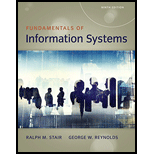
Concept explainers
Difference between data, information and knowledge and characteristics of quality data.
Explanation of Solution
Most of the people get confused with the data and information. Data can be anything or you can say any raw fact. Data can be in the form of numbers, pictures, and words. We cannot get exact information out of the data. Data is unprocessed, unorganized and can be in any random format but when that data is processed and organized it gives information when some context or meaningful words are added to the data and form the related information. You can say data is integrated and organized so that it is used by people in the form of information. On the other hand, knowledge is something we gain after processing the valuable information.
To make it clearer, let us take an example of a match. Suppose we have data as 68 and 70. We cannot get anything out of these numeric values. Now, by adding some context with these numeric values such as Team 1-68 and Team 2-70, we get information that Team 1 has scored 68 and Team 2 has scored 70. Now, from this information we can do comparison to gain knowledge that Team 2 has scored more and thus must have won the match.
Different characteristics of quality data are:
The first characteristic is that of Accuracy. Quality data should be accurate in context with for what purpose it is required.
Validity is another characteristic of quality data. Data should be valid in accordance to the requirements.
Timeliness is another characteristic of Quality data. Data should be collected at the time when it is needed. Data collected early or late can lead to incorrect results.
Completeness is an important characteristic of quality data. Data should always be complete because incomplete data cannot get the desired results.
Consistency: Data should be consistent. Data should not contradict at different sources.
Want to see more full solutions like this?
Chapter 1 Solutions
Fundamentals of Information Systems
 Fundamentals of Information SystemsComputer ScienceISBN:9781337097536Author:Ralph Stair, George ReynoldsPublisher:Cengage LearningCOMPREHENSIVE MICROSOFT OFFICE 365 EXCEComputer ScienceISBN:9780357392676Author:FREUND, StevenPublisher:CENGAGE L
Fundamentals of Information SystemsComputer ScienceISBN:9781337097536Author:Ralph Stair, George ReynoldsPublisher:Cengage LearningCOMPREHENSIVE MICROSOFT OFFICE 365 EXCEComputer ScienceISBN:9780357392676Author:FREUND, StevenPublisher:CENGAGE L Enhanced Discovering Computers 2017 (Shelly Cashm...Computer ScienceISBN:9781305657458Author:Misty E. Vermaat, Susan L. Sebok, Steven M. Freund, Mark Frydenberg, Jennifer T. CampbellPublisher:Cengage Learning
Enhanced Discovering Computers 2017 (Shelly Cashm...Computer ScienceISBN:9781305657458Author:Misty E. Vermaat, Susan L. Sebok, Steven M. Freund, Mark Frydenberg, Jennifer T. CampbellPublisher:Cengage Learning Principles of Information Systems (MindTap Course...Computer ScienceISBN:9781305971776Author:Ralph Stair, George ReynoldsPublisher:Cengage Learning
Principles of Information Systems (MindTap Course...Computer ScienceISBN:9781305971776Author:Ralph Stair, George ReynoldsPublisher:Cengage Learning Principles of Information Systems (MindTap Course...Computer ScienceISBN:9781285867168Author:Ralph Stair, George ReynoldsPublisher:Cengage Learning
Principles of Information Systems (MindTap Course...Computer ScienceISBN:9781285867168Author:Ralph Stair, George ReynoldsPublisher:Cengage Learning





